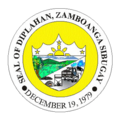Diplahan | |
|---|---|
| Municipality of Diplahan | |
 Integrated Bus Terminal | |
 Map of Zamboanga Sibugay with Diplahan highlighted | |
Location within the Philippines | |
| Coordinates: 7°41′28″N122°59′07″E / 7.6911°N 122.9853°E | |
| Country | Philippines |
| Region | Zamboanga Peninsula |
| Province | Zamboanga Sibugay |
| District | 1st district |
| Barangays | 22 (see Barangays) |
| Government | |
| • Type | Sangguniang Bayan |
| • Mayor | Eric Y. Palma |
| • Vice Mayor | Ramil M. Villaruel |
| • Representative | Marlo Bancoro |
| • Municipal Council | Members |
| • Electorate | 22,160 voters (2025) |
| Area | |
• Total | 255.51 km2 (98.65 sq mi) |
| Elevation | 106 m (348 ft) |
| Highest elevation | 369 m (1,211 ft) |
| Lowest elevation | 1 m (3.3 ft) |
| Population (2024 census) [3] | |
• Total | 32,423 |
| • Density | 126.90/km2 (328.66/sq mi) |
| • Households | 7,370 |
| Economy | |
| • Income class | 3rd municipal income class |
| • Poverty incidence | 28.22 |
| • Revenue | ₱ 228.1 million (2022) |
| • Assets | ₱ 502.3 million (2022) |
| • Expenditure | ₱ 176.9 million (2022) |
| • Liabilities | ₱ 163.2 million (2022) |
| Service provider | |
| • Electricity | Zamboanga del Sur 2 Electric Cooperative (ZAMSURECO 2) |
| Time zone | UTC+8 (PST) |
| ZIP code | 7039 |
| PSGC | |
| IDD : area code | +63 (0)62 |
| Native languages | Subanon Cebuano Chavacano Tagalog |
Diplahan, officially the Municipality of Diplahan (Cebuano : Lungsod sa Diplahan; Hiligaynon : Banwa sang Diplahan; Chavacano : Municipalidad de Diplahan; Tagalog : Bayan ng Diplahan), is a municipality in the province of Zamboanga Sibugay, Philippines. According to the 2020 census, it has a population of 32,585 people. [5]



